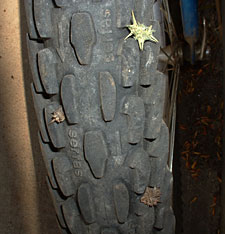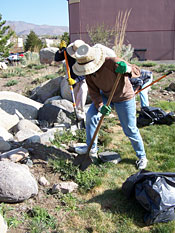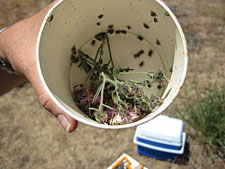Weed Management
As with all pest management, it is essential to identify the pest before taking action. Submit fresh plant samples to the University of Nevada Cooperative Extension or Nevada Department of Agriculture. Weeds are easiest to identify when they are flowering. Place the sample in a bag to avoid spreading seeds.
Most effective weed management plans include several control strategies. Weed control can be divided into five separate categories.
Prevention
Prevention includes using certified weed-free seed, hay and fill materials, or using transplants, amendments and mulches that are known to be weed-free. Cleaning vehicles and equipment to prevent the spread of weed seed and weed plant parts from one area to another is another prevention tactic. Prevention also includes removing weeds before they can form seed heads or spread by other methods. It is more difficult to prevent weed seeds from blowing in from an adjoining property.

Puncturevine seeds stick to bicycle tires and spread to new areas.
Clean seeds off after traveling through an infested area to reduce future problems.
Photo credit: University of Nevada, Reno Extension
Cultural controls
Cultural controls are management practices that reduce the incidence of weed infestations. Cultural controls include using proper planting times and planting rates, planting companion crops, mulching, managing fertilization and irrigation to favor desired plants rather than weeds, rotating crops and planting cover crops.
Mechanical/Physical controls
These controls physically disrupt the weed, including hand-pulling, hoeing, mowing, tilling, flooding, etc.

Hand-removal of weeds is a time-honored practice that works well for many weeds.
Photo credit: University of Nevada, Reno Extension
Biological controls
Biological control is the use of a living organism to manage pests. This method rarely results in complete eradication of weeds. The most common biological controls for weed management include livestock and insects. Success depends upon selectivity, reproduction, adaptation, and ability of the organism to reach a high level of effectiveness. Some examples: the saltcedar leaf-eating beetle, Dyers woad rust fungus, grass carp, livestock that feed on weeds, etc.

Hand-removal of weeds is a time-honored practice that works well for many weeds.
Photo credit: University of Nevada, Reno Extension
Chemical controls
Chemical control involves the use of pesticides to manage pests. Pesticides that control weeds are called herbicides. Many herbicides are available. Read the product label carefully and know how they are used and how they work before you apply them.
- Selective herbicides: Chemicals that kill specific types of plants, such as grass plants or broadleaf plants.
- Nonselective herbicides: Chemicals that kill all types of plants. A common example is glyphosate, the active ingredient in Roundup and many other herbicides.
- Contact herbicides: Chemicals that kill the plant only where the chemical touches it. To be effective, the entire plant must be thoroughly covered with the product. They are quick-acting and useful in controlling annuals, biennials and seedling perennials.
- Systemic herbicides: Chemicals that are absorbed through the leaves or roots and move freely throughout the plant. Application to part of the plant will kill the entire plant. Systemic herbicides are effective against most plants and are recommended for perennials. They take time to be effective, and may be soil- or foliage-applied.
- Soil-applied materials may be selective or nonselective, depending upon the material and the rate of application.
Hefner, M.
2019,
Weed Management,
Extension | University of Nevada, Reno. IP


